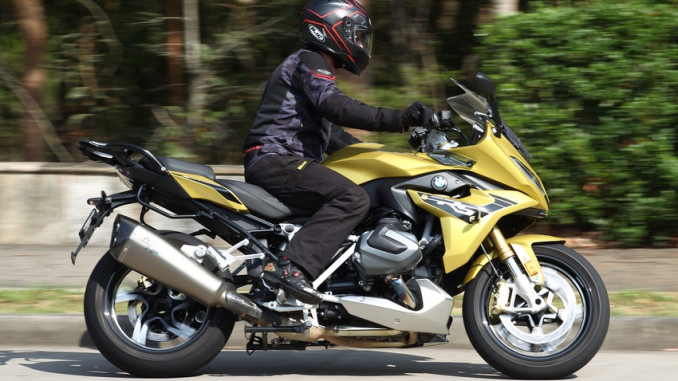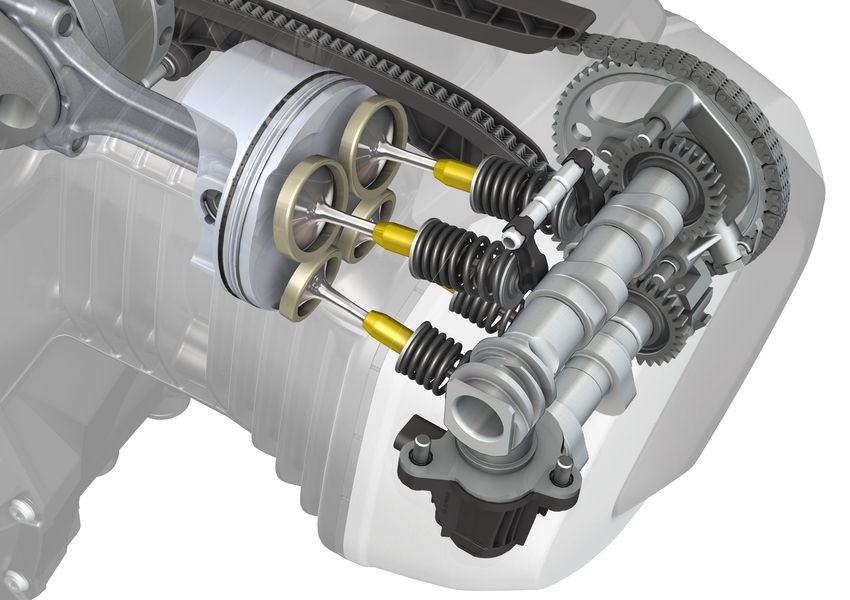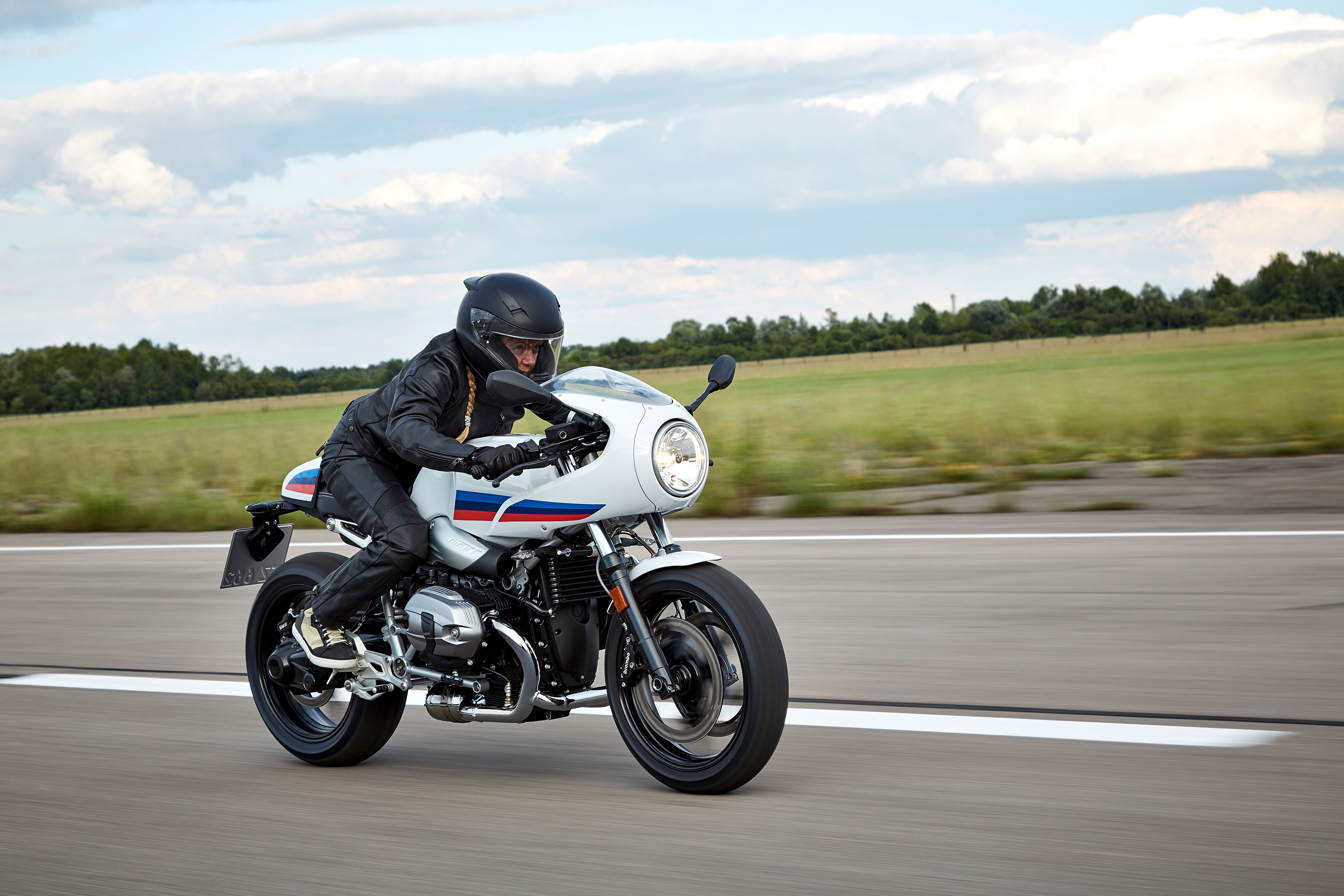
A sports-tourer with all the bells and whistles…
BY: NIGEL PATERSON | PHOTOGRAPHY: BMW/PATERSON
BMW shocked the world with its first RS model, back in the 1970s, producing a fully-faired machine that was comfortable, fast and handled well. The current RS still ticks those boxes, and it does so really, really well.
This model we rode is the Sport variant, which really means it comes with the Austin Yellow paint and various styling differences and equipment levels compared to the standard model and the Exclusive, the three models in the range (2019’s Spezial model has been dropped). If you’d like a distinctive look, there are the 719 Option accessories available.
The Sport is, in many mays, the top of the range, with the highest level of standard equipment and electronics. As such it’s fast, capable and
can be ridden all day without a masseuse waiting at your destination.
At over 30 grand on the road, it’s priced at the top end of sports-tourers available today, just as all the RS models have been. In 2020 you get a lot for your money, but there’s no getting away from the reality — it is a lot of money.
SHIFTCAM ENGINE
The engine in the R 1250 RS is the best Boxer engine I’ve ever experienced. The changes made for the latest 1254cc version have made it the smoothest, gruntiest, easiest-shifting and most fun Boxer ever produced.
The 136hp are produced at 7750rpm, but you’ll almost never get there because the torque (143Nm at 6250rpm) provides so much mid-range it’ll have you rocketing between corners as fast as you want to go.
On public roads I never found myself looking for more power or torque; sure, on bikes like the S 1000 XR it’s fun to get silly with all those extra horses, but you certainly don’t need them on Australia’s crappy roads.
The ShiftCam engine has a differential inlet camshaft to provide different valve timing at different revs. At low engine speeds, the intake valves have reduced, asynchronous lift, which increases torque. At higher engine speeds the camshaft slides over to expose different cam lobes, increasing lift to produce more power. If you don’t understand the intricacies of valve timing, valve lift and asynchronous lift, don’t worry — what it adds up to is the smoothest, most powerful BMW twin ever.
Torque is up 14 per cent on the older model but it feels like more.
Other characteristics of the new Boxer motor are, in some ways, even more impressive than the ShiftCam technology — things like the gearbox, which is the slickest-changing Boxer we’ve ever ridden.
At idle the 1250 shakes about like modern Boxers have for years, but when moving it smooths out beautifully.
ELECTRONICS AND EQUIPMENT
There’s a pretty-much full suite of modern electronics on the R 1250 RS. There are safety features like the latest-generation ABS and ASC (stability/traction control), convenience features like various riding modes and cruise control, a beautiful TFT instrument panel with Bluetooth connectivity, heated handgrips and now an LED headlight.
The Sport model includes both the Touring Package (Dynamic ESA, Keyless Ride, Navigation Preparation, Cruise Control, Centrestand, Pannier Mounts and Luggage Grid) and Dynamic Package (Daytime Running Lights, White LED Indicators, Gear Shift Assist Pro and Riding Modes Pro).
I really like the touring package for the ESA, or Electronic Suspension Adjustment. Having suspension which can be configured for the weight you’re carrying and the roads you are riding right now is a great thing. Cruise control and a centrestand should be standard equipment.
I’m less impressed with Navigation Preparation and Pannier Mounts, for these should be supplied with the navigation system and panniers if you buy them — not fitted to your bike to look ugly until you spend more money.
While they weren’t supplied on the test bike, I’ve used both BMW’s navigation system and panniers in the past, and both are well made and very good at doing their job. The navigation system, though, is becoming less and less necessary thanks to improvements in mobile phone navigation and interaction with Bluetooth-enabled instruments. Put simply, it’s getting less and less beneficial to use a navigation unit when your phone does such a great job, although there are benefits to having a dedicated GPS unit and ARR is currently preparing an article for a future issue which goes to the heart of navigation.
SUSPENSION AND BRAKES
Suspension which automatically responds to the way you ride and the road surface it’s being impacted by really is the future. Being able to configure it to the load being carried and how you’d like it to perform is an added bonus, which is all there for the button pressing on an ESA-equipped R 1250 RS.
Optional on the base model and standard on the Sport and Exclusive, Dynamic ESA sets the spring preload automatically based on the riding conditions, weight of rider, passenger and luggage. Damping is adjusted on the fly, changing in milliseconds to provide the best-handling, most comfortable and confidence-inspiring ride it can.
The different riding modes selected by the rider — Road, Dynamic, Pro — prompt the system to provide a sportier set-up.
RIDING MODES
The R 1250 RS Sport includes Rain, Road and Dynamic Pro modes. You can guess what the first two are aimed at doing; Dynamic Pro is for even sportier riding. Selecting Dynamic Pro will reduce the intrusiveness of the DTC (Dynamic Traction Control) but more importantly each characteristic of the systems can be tailored to suit an owner’s preference.
On the bumpy roads Australian Road Rider tests bikes on, the R 1250 RS’s suspension performance was excellent. The Dynamic suspension system proved itself capable of keeping the wheels on the ground where they belong while keeping the rider comfortable.
On a sports-tourer like the RS, having electronic suspension which adapts automatically to a poor road surface or freeway to someone jumping on the back for a ride is fantastic.
While a carefully set-up conventional suspension system might perform better in some conditions, the dynamic suspension of the RS means you’ll almost never have to adjust suspension yourself, yet still get
a close to perfect ride, which is pretty amazing.
ERGOS AND BODYWORK
Fully faired machines generally punish their riders in Australia, because all the vents in the world can’t make up for the acres of plastic and Perspex in front of you heading down the highway.
Sports-tourers, on the other hand, may still get a bit warm in the heat and you might be wishing for a bit more protection in the cold, but 90 per cent of the time for 90 per cent of riders, the RS offers a great compromise between protection and breeze.
BMW has been designing its fairings in wind tunnels for decades, and the RS’s works really well, matching the design brief.
The screen is manually adjustable, although not by much. It does angle forward as it lifts at the top more than at the bottom, improving its effectiveness at keeping the wind blast down. To change the position
is simple but requires two hands, so it’s impractical to do so on the move.
The seat is well designed, firm and comfortable all day. It’s really excellent, not getting in your way when pushing through corners but not being a plank on a long ride either. In standard trim seat height is 820mm, but feels taller — options include the low seat at 760mm (which I’m guessing would be pretty thinly padded) or the sports seat at 840mm.
Nestled inside the fairing is a giant 6.5in TFT instrument panel that can display all sorts of information about your ride — even lean angle, not something I was expecting on a sports-tourer. It’s a comprehensive panel which provides lots and lots of info about the bike and what you’ve been doing with it.
The Bluetooth connectivity of the giant instruments looks to be excellent (although I didn’t get the chance to try it out), with the system able to help you with navigation, display music that’s playing and lots more.
On the app (BMW Motorrad Connected) you can create a route or upload a GPX (navigation) file to plan your trip. Or get the app to find you a route — scenic, winding or fastest. The bike’s handlebars have controls to directly access information and control aspects of your phone.
THE RIDE
The R 1250 RS is a distinctive motorcycle. The sport variant’s colour — what many would describe as matt gold and BMW calls Austin Yellow — is unusual and the white frame, black wheels, silver bellypan and Akropovic muffler all help to give it a unique look.
The riding position is on the sporty side of neutral; like every RS before it, there’s a lean into the breeze and footpegs which aren’t forward, aren’t rearset, although they are high enough not to compromise cornering clearance.
Lifting it off the sidestand reveals the not-inconsiderable 243kg wet weight, but at least with the Boxer engine the centre of gravity is low. That weight includes 18 litres of fuel, enough to get you around 350km. BMW claims 4.75 litres/100km; I used a little more (but I’m tall, I stick up in the breeze, and I wasn’t trying to be conservative).
Ride it slowly — on busy city streets — and it feels a touch heavy in the steering and you’ll feel a little weight on your wrists. As speeds rise, there’s enough breeze coming around the bodywork to lift that weight, making the RS very comfortable around the highway speed limit, and the sporty riding position starts to really come into its own when the countryside corners start flowing.
The tyres are just the right size — 120/70 ZR 17 front and 180/55 ZR 17 rear — which means you’ve got about a million options from touring to race when it comes to requiring new rubber. From tight bends signposted at 35km/h through to fast open sweepers, the RS goes where you point it, the grunty twin shortening the distance between corners to keep you focussed on the ride.
While it’s not a race replica, a good rider can make very quick progress on a winding public road. The strong midrange means there’s no requirement to keep the revs in the stratosphere, while the ESA means the suspension responds to the road surface beautifully.
If something starts to go awry, the RS is a better place to be than most bikes. BMW has been installing ABS longer than any other manufacturer and has got its systems working beautifully, even when cranked over. The riding modes are well sorted and the fuelling is essentially faultless. Add in the big brakes, LED lighting and the capability to do all this with a passenger and you’ve got a very capable motorcycle.
Where the R 1250 R is the city roads blaster thanks to quicker steering and less bulk and the R 1250 RT is the long-distance tourer, the RS is the twisty road bike. Without any luggage it’s a fine day-ride bike, the fairing taking the blast so you can ride the twisty mountain roads you love all day long, yet it will get through the traffic in and out of town without fuss.
And while it might not be quite so comfortable as the RT when luggage is attached and the open road beckons, it’s not back-breaking either.
And that’s the ideal use case for the BMW R 1250 RS. It’s ideal for someone who rides hard in the twisties, spends more time in traffic than they might like, and does go on tour every now and then.
VARIANTS
You can choose three different variants of the R 1250 RS, with the Option 719 special equipment also available.
R 1250 RS: $23,320 + Government Charges
Available only in Black Storm Metallic, the standard R 1250 RS for Australia features BMW Motorrad ABS, ASC (stability control), riding modes, TFT Connectivity Display, adjustable levers, one keylock system, engine spoiler and the Comfort Package: chrome exhaust, heated grips and tyre pressure monitoring.
R 1250 RS Sport: $29,185 + Government Charges
The model we tested, the Sport, is only available in Austin Yellow Metallic, with a white frame, silver anodised fork tubes, gold brake calipers and a stainless engine spoiler. The Sport additions include: HP Exhaust, chrome exhaust headers and Pure tank cover, the Touring Package (Dynamic ESA, keyless ride, GPS mount, cruise control, centre stand, pannier mounts and a luggage rack) and the Dynamic Package (daytime running lights, white LED indicators, gear shift assist pro, riding modes pro).
R 1250 RS Exclusive: $28,185 + Government Charges
The Exclusive is available only in Imperial Blue Metallic. It adds to the standard model the Dynamic Package (daytime running lights, white LED indicators, gear shift assist pro, riding modes pro) and the pure tank cover.
The competition
Sports-tourers come in a variety of shapes and sizes, but if you want shaft drive, the
R 1250 RS is your bike.
MV Agusta Turismo Veloce Lusso: $32,590 ride away
You might think an 800 can’t compete with a 1250, but with 110 horsepower and pushing only 192kg, MV’s Turismo Veloce has plenty of sports-touring performance. Standard panniers, LED lights, semi-active suspension, heated grips and a centre stand are all standard.
Yamaha Tracer GT: $20,349 ride away
Three pots, a protective fairing and a reasonably upright riding position make this MT-09-based machine great for touring while still offering decent sports performance. Full-colour TFT instruments, quick shift, cruise control and standard panniers.
Kawasaki Ninja 1000SX: $17,199
+ ORC
Kawasaki’s 2020 Ninja 1000SX is now in its fourth generation and offers lots of performance, technology and versatility for a low price. Sportier than most of the bikes in this line-up yet still with reasonable comfort, the Ninja has an adjustable screen, thick padded seats, cruise control, quickshifter, advanced electronics
and various power modes. Hard luggage is an option.
SPECIFICATIONS – 2020 BMW R 1250 RS Sport
ENGINE
Type: Air/liquid-cooled four-stroke flat twin engine,
double overhead camshaft, one balance shaft and variable
engine timing system BMW ShiftCam.
Capacity: 1254cc
Bore x stroke: 102.5 x 76mm
Compression ratio: 12.5: 1
Fuel system: Electronic intake pipe injection
Fuel: Premium 95 (adaptive 91 to 98)
Electrical: 508W nominal
PERFORMANCE
Claimed maximum power: 134hp (100kW) at 7750rpm
Claimed maximum torque: 143nm at 6250rpm
TRANSMISSION
Type: 6-speed, helical gears, Gearshift Assist Pro
Final drive: Shaft
Clutch: Wet, hydraulic
CHASSIS AND RUNNING GEAR
Chassis: Two-section frame, front and bolted on rear frame,
load-bearing engine
Front suspension: 45USD forks, 140mm of travel
Rear suspension: Cast aluminium single-sided swing arm with BMW Motorrad Paralever. Dynamic Electronic Suspension Adjustment
Front brakes: Hydraulic dual discs, 320mm, four-piston calipers, ABS
Rear brake: Hydraulic single disc, 276mm, single-piston caliper, ABS
Tyres: Front: 120/70 ZR 17; Rear: 180/55 ZR 17
ELECTRONIC RIDER AIDS & INCLUDED EXTRAS
Riding modes: Pro (Rain, Road, Dynamic, Dynamic Pro), Gearshift Assist Pro, white LED indicators, daytime running lights, heated grips, tyre pressure monitoring, luggage grid, 6.5in TFT instrument display, Electronic Suspension Adjustment, cruise control, centrestand, navigation preparation, pannier mounts, keyless ride, BMW ABS Pro — Cornering ABS, DTV — Dynamic Traction Control
DIMENSIONS AND CAPACITIES
Steering head angle: 62.3°
Trail: 110.9mm
Claimed wet weight: 243kg
Payload: 217kg
Seat height: 820mm (OE low seat: 760mm; OE sport seat: 840mm)
Wheelbase: 1,530mm
Fuel capacity: 18L
ETCETERA
Price: $28,215 (Sport model, excluding dealer delivery
and government charges)
Colour: Austin Yellow
Test bike supplied by: BMW Australia
Website: www.bmw-motorrad.com.au
Warranty: 3 years, unlimited kilometres









